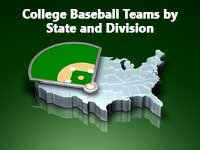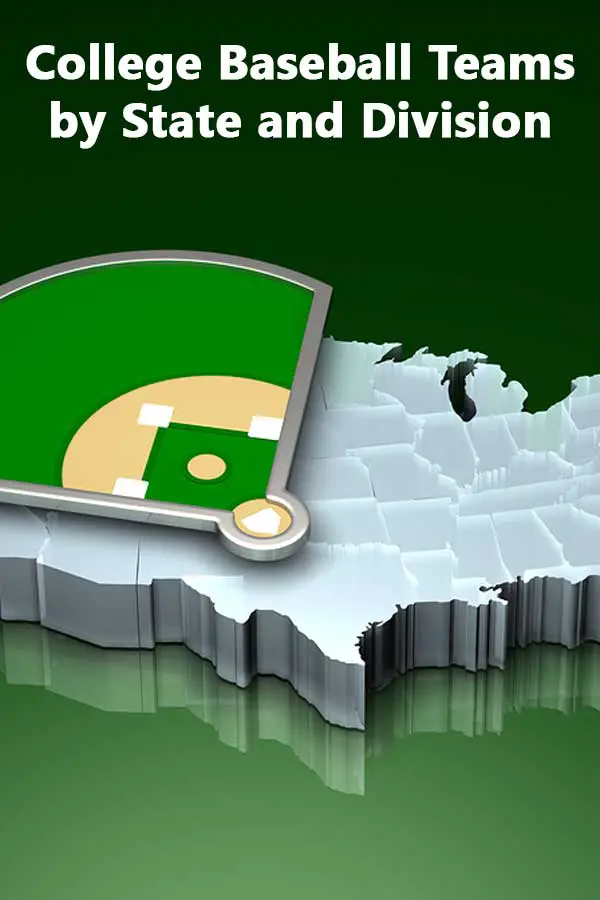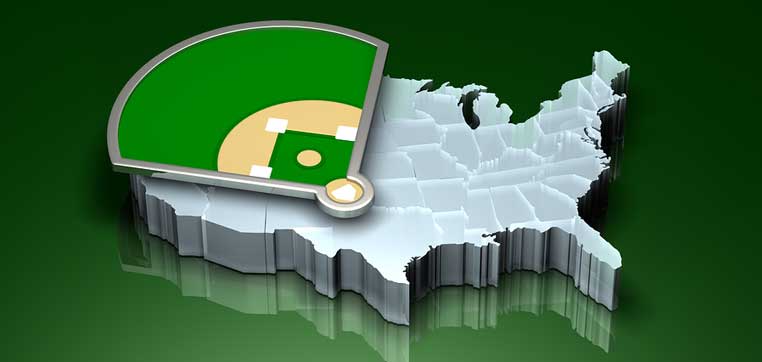 Do you know which state, New York or Texas, offers more college baseball teams? You’re wrong if you said Texas. Texas offers more D1 and Junior College programs but New York has more D2 baseball teams and over three times the number of D3 teams. Knowing which states offer which types of college baseball teams can improve your chances of making a college team. (This combined with the DIY College Rankings Baseball Spreadsheet forms the foundation for your college search.)
Do you know which state, New York or Texas, offers more college baseball teams? You’re wrong if you said Texas. Texas offers more D1 and Junior College programs but New York has more D2 baseball teams and over three times the number of D3 teams. Knowing which states offer which types of college baseball teams can improve your chances of making a college team. (This combined with the DIY College Rankings Baseball Spreadsheet forms the foundation for your college search.)
|
Over 1600 Colleges, 121 Conferences, 14 Divisions |
Which Colleges Offer Baseball
It’s important to remember that colleges do not offer all sports. There are over 1,500 4-year colleges in the United States. However, fewer than a 1,000 participate in NCAA Baseball. The NAIA programs increases the number by less than 200. Alaska and Wyoming don’t offer any college baseball teams. Athletes in any sport need to pay close attention to which colleges actually offer their sports.
Players should also keep track of whether or not the college is public or private given the limited number of available baseball scholarships. A partial scholarship will go a lot further at a public university than at a private institution. The largest division in college baseball, NCAA D3, doesn’t allow any athletic scholarships and there are four times as many private colleges as public in the division. At the D1 level, the public universities outnumber the private by two to one.
Not All Scholarships are Fully Funded
Athletes and their families also need to keep in mind that just because the NCAA sets the limits for scholarships doesn’t mean that colleges fully fund all scholarships. Furthermore, depending on the sport, they may be competing with foreign athletes for roster positions. Baseball players don’t have to worry too much about this, it’s one of the sports with the lowest competition.
Below is a table listing the number of colleges in each state offering baseball by the sanctioning organizations. You can sort the table to find out which states have the most NCAA Division 1 college baseball teams or the most Junior College teams. These numbers are based on data from the Office of Postsecondary Education (OPE), the NCAA, and the NAIA. Because of teams changing divisions and conferences, the actual numbers may vary. Following the table is a brief description of the organizations and their requirements.
Number of College Baseball Teams by State
(included in the Baseball Spreadsheet)
| State | NAIA | NCAA D1 | NCAA D2 | NCAA D3 | NCAA All | NJCAA | Other | Grand Total |
| Alabama | 4 | 10 | 7 | 2 | 19 | 16 | 39 | |
| Alaska | ||||||||
| Arizona | 3 | 4 | 4 | 12 | 2 | 21 | ||
| Arkansas | 4 | 5 | 7 | 2 | 14 | 3 | 2 | 23 |
| California | 14 | 25 | 19 | 12 | 56 | 1 | 89 | 160 |
| Colorado | 2 | 8 | 10 | 5 | 15 | |||
| Connecticut | 7 | 4 | 7 | 18 | 1 | 19 | ||
| Delaware | 2 | 2 | 1 | 5 | 1 | 6 | ||
| District of Columbia | 2 | 2 | 4 | 4 | ||||
| Florida | 9 | 13 | 13 | 26 | 23 | 2 | 60 | |
| Georgia | 7 | 6 | 16 | 6 | 28 | 6 | 1 | 42 |
| Hawaii | 1 | 2 | 3 | 3 | ||||
| Idaho | 2 | 1 | 1 | 2 | 1 | 5 | ||
| Illinois | 10 | 11 | 4 | 21 | 36 | 38 | 4 | 88 |
| Indiana | 14 | 9 | 3 | 9 | 21 | 2 | 37 | |
| Iowa | 11 | 1 | 1 | 11 | 13 | 10 | 1 | 35 |
| Kansas | 13 | 3 | 5 | 8 | 18 | 2 | 41 | |
| Kentucky | 12 | 8 | 2 | 4 | 14 | 26 | ||
| Louisiana | 3 | 12 | 2 | 14 | 5 | 22 | ||
| Maine | 1 | 9 | 10 | 2 | 12 | |||
| Maryland | 7 | 1 | 6 | 14 | 9 | 4 | 27 | |
| Massachusetts | 1 | 7 | 4 | 36 | 47 | 2 | 50 | |
| Michigan | 10 | 6 | 6 | 8 | 20 | 14 | 1 | 45 |
| Minnesota | 1 | 8 | 18 | 27 | 1 | 13 | 41 | |
| Mississippi | 3 | 6 | 2 | 2 | 10 | 15 | 2 | 30 |
| Missouri | 12 | 4 | 14 | 4 | 22 | 6 | 3 | 43 |
| Montana | 1 | 1 | 2 | 3 | ||||
| Nebraska | 7 | 3 | 1 | 1 | 5 | 4 | 16 | |
| Nevada | 2 | 2 | 1 | 3 | ||||
| New Hampshire | 1 | 3 | 5 | 9 | 2 | 11 | ||
| New Jersey | 8 | 3 | 15 | 26 | 3 | 11 | 40 | |
| New Mexico | 1 | 2 | 2 | 4 | 3 | 8 | ||
| New York | 18 | 13 | 48 | 79 | 2 | 23 | 104 | |
| North Carolina | 2 | 18 | 12 | 7 | 37 | 11 | 3 | 53 |
| North Dakota | 4 | 1 | 2 | 3 | 4 | 11 | ||
| Ohio | 6 | 12 | 9 | 22 | 43 | 5 | 5 | 59 |
| Oklahoma | 7 | 3 | 11 | 14 | 8 | 3 | 32 | |
| Oregon | 3 | 4 | 1 | 5 | 10 | 9 | 22 | |
| Pennsylvania | 1 | 10 | 20 | 55 | 85 | 1 | 18 | 105 |
| Puerto Rico | 3 | 3 | 11 | 14 | ||||
| Rhode Island | 3 | 4 | 7 | 1 | 8 | |||
| South Carolina | 4 | 11 | 12 | 23 | 6 | 33 | ||
| South Dakota | 4 | 1 | 3 | 4 | 8 | |||
| Tennessee | 7 | 11 | 10 | 3 | 24 | 10 | 1 | 42 |
| Texas | 10 | 22 | 9 | 16 | 47 | 29 | 8 | 94 |
| Utah | 5 | 5 | 1 | 6 | ||||
| Vermont | 1 | 4 | 5 | 5 | ||||
| Virginia | 1 | 13 | 2 | 17 | 32 | 3 | 2 | 38 |
| Washington | 4 | 2 | 4 | 10 | 18 | 28 | ||
| West Virginia | 1 | 2 | 14 | 1 | 17 | 1 | 19 | |
| Wisconsin | 1 | 1 | 2 | 21 | 24 | 2 | 3 | 30 |
| Wyoming | ||||||||
| Grand Total | 191 | 309 | 265 | 390 | 964 | 282 | 249 | 1686 |
Find out the specific colleges for each state with the DIY College Rankings Baseball Spreadsheet.
Keep in mind that individual conferences can have additional rules than just those required by the sanctioning body.
College Athletics Sanctioning Bodies
NAIA (National Association for Intercollegiate Athletics)
NAIA colleges can offer up to 12 baseball scholarships and allow for up to two days of on campus tryouts. Prospective students must register with the NAIA Eligibility Center. Prior to COVID, students had to meet two of the following three requirements to be eligible to play:
- Minimum score of 18 on the ACT or 860 on the SAT (Critical Reading and Math)
- Have a 2.0 high school grade point average on a 4.0 scale
- Be ranked in the top half of the graduating class
Starting in the Fall of 2022: “entering freshman beginning in the fall of 2022 will be able to meet initial eligibility requirements by only meeting the elevated GPA requirement of 2.300 on a 4.000 scale.” Furthermore, “students can receive an early decision of eligible based solely on their high school GPA. A student who has a 3.300 or higher after their sixth semester of high school and a student with a 2.800 or higher after their seventh semester can receive early decisions of eligible.”
There are a limited number of restrictions on contact between the coach and prospective player, generally centering on evaluations.
NCAA (National Collegiate Athletic Association)
The majority of colleges belong to the NCAA. The NCAA is divided into three divisions. Divisions 1 and 2 may offer scholarships. Division 3 schools do not offer scholarships. The NCAA is in the process of making permanent changes to its eligibility rules for Division 1 and Division 2 after COVID. Be sure to check their website for the latest requirements.
Division 1: Colleges in this division may offer up to 11.7 equivalency baseball scholarships. The minimum requirement for a baseball scholarship is 25% with the maximum number of 27 scholarships allowed per team. Teams in this division may only carry 35 players on their roster.
There are numerous requirements and rules for this division so players should pay close attention to the eligibility requirements in the Guide for the College-Bound Student-Athlete. Prospective players must register with the NCAA eligibility center. For the coming academic year, the NCAA states that:
student-athletes enrolling in a Division I school during the 2022-23 academic year will be academically eligible by earning a 2.3 grade-point average in 16 NCAA-approved core courses, with 10 core courses (seven in English, math and science) completed by the start of their seventh semester in high school (before senior year).
Division 2: Colleges in this division may offer up to 9 equivalency baseball scholarships. Academic eligibility requirements are less complicated than D1 and there are fewer restrictions in terms of amateur status. As in the case for Division 1, the NCAA is revising its eligibility rules for Division 2. For the coming academic year, “Student-athletes enrolling in a Division II school during the 2021-22 or 2022-23 academic year will be academically eligible by earning a 2.2 grade-point average in 16 NCAA-approved core courses.”
Division 2 is the only one that allows college baseball teams to offer tryouts for prospective students. Pay close attention to the eligibility requirements in the Guide for the College-Bound Student-Athlete. Prospective students for Division 2 colleges must register with the NCAA eligibility center.
Division 3: Colleges in this division do not offer any athletic scholarships. Rules for recruiting and eligibility are determined by individual conferences. Prospective players do not have to register with the NCAA Eligibility center.
This is the largest of the three divisions which spans the talent spectrum. Some programs will regularly have players in the MLB draft where at others it’s virtually unheard of. This division also contains the majority of academically demanding schools (exceptions include the Ivy League and Stanford) where being recruited by the baseball coach may help your chances for admission.
NCCAA (National Christian College Athletic Association)
The NCCAA consists of primarily bible colleges and small Christian colleges and is divided into two divisions. Division 1 colleges may offer up to 12 baseball scholarships. Division 2 colleges are not allowed to offer any athletic scholarships. Entering freshman are required to meet two of the following three requirements to participate in athletics:
- Minimum score of 18 on the ACT or 860 on the SAT
- Minimum GPA of 2.0 on a 4.0 scale
- Top half of high school graduating class
NJCAA (National Junior College Athletic Association)
The NJCAA consists of 3 divisions with only divisions 1 and 2 offering scholarships. These are generally two-year programs with an occasional school offering some four-year programs.
NJCAA colleges offer 24 scholarships and unlike four-year colleges, players can be on the roster and remain eligible for the draft. Because of this rule, an increasing number of baseball players who want to improve their draft position have taken to playing for a Junior College baseball team to improve their skills for the following year’s draft. That means some of these teams have very high-quality players on their rosters, including some who have turned down offers from D1 schools. Therefore, do not assume that if you aren’t picked up by a D1 or D2 team, you can always play at the local junior college.
As for eligibility, you need a high school diploma and then according to the NJCAA website:
Due to the unique academic and athletic situation of each individual, and the complexity of the NJCAA eligibility rules, it is recommended that each potential student-athlete discuss their athletic eligibility with the athletic personnel at the NJCAA college where they have chosen to attend.
CONNECT WITH OTHER PARENTS WITH PROSPECTIVE COLLEGE ATHLETES
JOIN THE COLLEGE RECRUITING PARENT ZONE



5 thoughts on “College Baseball Teams by State and Division”